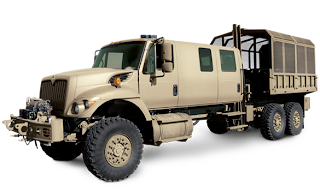The Navistar 7000 is a U.S. built general purpose heavy transport utility vehicle used by Iraqi Ministry of Defense, military and police in Afghanistan, as well as the Canadian military.The basic chassis platform supports a variety of drive-trains and configurations. It is this particular configuration that is causing some concern among civilian watchdogs...
It certainly appears to be some sort of prisoner transport. Conspiracy theorists are alarmed that these units may be a sign of impending martial law and mass incarceration of civilians here in the United States. Looking at these units, it's not hard at all to imagine them rumbling through American neighborhoods rounding up families to be shipped off to FEMA camps in some sort of Nazi-esque Orwellian nightmare. They also point out the paint scheme of these units, which suggest that they are destined for domestic deployment, rather than being shipped overseas. If they were being sent to Iraq or Afghanistan, they would be painted tan most likely.
Looking at the company's web-page for the 7000, we don't see this particular configuration. However, there is a crew-cab design which is similar, equipped with what they call a "cage." It is also listed as ideal for Homeland Security applications when you tick the check-box in the left column. Naturally they say this cage is for equipment, but clearly it is a secured space meant to keep people out... or keep people in. After all, being a prisoner really just comes down to which side the lock is on.
If we are to accept that this cage is simply for equipment, we have to ask what the advantages of this construction really are. Why not use the traditional canvas cover, which most of their pictured vehicles still utilize? After all, with the canvas top, the space is multipurpose, allowing it to be utilized for transport of people or equipment. The space is also more protected from natural environmental factors such as sunlight, rain, sand, etcetera, under a canvas top. With the cage equipped, they sacrifice both of those advantages to gain a more heavily secured space. Is there really such a rash of military equipment being stolen from under the noses of armed personnel, that is has to be locked up in a cage? Let's keep in mind here too, that the military does everything out of necessity. Military vehicles are no-frills designs mindful only of the mission task in order to save defense budget dollars for other projects.
In the second unit pictured, it might be more believable that the personnel aboard had some need to secure equipment in the back or their rig. What that equipment might be I can't immediately imagine, but perhaps it is an advantageous design for certain specialized missions. That becomes harder to accept though, seeing the full-sized cage transport, and knowing that Navistar has just filled a 10,000-unit order of the 7000-MV model. What is the military moving so much of which must be kept under lock and key, while being operated by armed personnel?
As a final consideration here, we can look at other vehicle designs, to see whether this sort of configuration has been utilized in the past. The Soviet-design GAZ-66 was an extremely popular transport design, used by many countries in many configurations including personnel carrier...
...and prisoner transport...
Given the state of affairs in this country it is a worrisome design to
say the least. It seems more likely that these units are indeed designed
to transport people as chattel, against their will and exposed to the
elements, rather than simply keeping equipment under lock and key while
on the road.
Tweet



